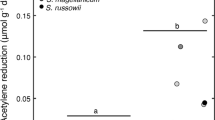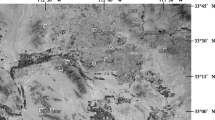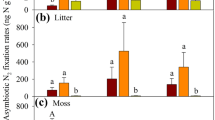Abstract
Nitrogen (N) fixation in the feather moss–cyanobacteria association represents a major N source in boreal forests which experience low levels of N deposition; however, little is known about the effects of anthropogenic N inputs on the rate of fixation of atmospheric N2 in mosses and the succeeding effects on soil nutrient concentrations and microbial community composition. We collected soil samples and moss shoots of Pleurozium schreberi at six distances along busy and remote roads in northern Sweden to assess the influence of road-derived N inputs on N2 fixation in moss, soil nutrient concentrations and microbial communities. Soil nutrients were similar between busy and remote roads; N2 fixation was higher in mosses along the remote roads than along the busy roads and increased with increasing distance from busy roads up to rates of N2 fixation similar to remote roads. Throughfall N was higher in sites adjacent to the busy roads but showed no distance effect. Soil microbial phospholipid fatty acid (PLFA) composition exhibited a weak pattern regarding road type. Concentrations of bacterial and total PLFAs decreased with increasing distance from busy roads, whereas fungal PLFAs showed no distance effect. Our results show that N2 fixation in feather mosses is highly affected by N deposition, here derived from roads in northern Sweden. Moreover, as other measured factors showed only weak differences between the road types, atmospheric N2 fixation in feather mosses represents a highly sensitive indicator for increased N loads to natural systems.






Similar content being viewed by others
References
Adams DG. 2002. The liverwort: cyanobacterial symbiosis. Biol Environ 102B:27–9.
Alden L, Demoling F, Bååth E. 2001. Rapid method of determining factors limiting bacterial growth in soil. Appl Environ Microbiol 67:1830–8.
Bakirdere S, Yaman M. 2008. Determination of lead, cadmium and copper in roadside soil and plants in Elazig, Turkey. Environ Monit Assess 136:401–10.
Bell S, Ashenden TW, Rafarel CR. 1992. Effects of rural roadside levels of nitrogen dioxide on Polytrichum formosum Hedw. Environ Pollut 76:11–14.
Bernhardt-Römermann M, Kirchner M, Kudernatsch T, Jakobi G, Fischer A. 2005. Changed vegetation composition in coniferous forests near to motorways in Southern Germany: the effects of traffic-born pollution. Environ Pollut 143:572–81.
Biasi C, Wanek W, Ruslimova O, Kaiser C, Meyer H, Barsukov P, Richter A. 2005. Microtopography and plant-cover controls on nitrogen dynamics in hummock tundra ecosystems in Siberia. Arct Antarct Alp Res 37:435–43.
Bignal KL, Ashmore MR, Alistair DH. 2008. Effects of air pollution from road transport on growth and physiology of six transplanted bryophyte species. Environ Pollut 156:332–40.
Boxman AW, van Dam D, van Dijk HFG, Hogervorst RF, Koopmans CJ. 1995. Ecosystem responses to reduced nitrogen and sulphur inputs into two coniferous forest stands in the Netherlands. For Ecol Manage 71:7–29.
Caporn SJM, Ashenden TW, Lee JA. 2000. The effect of exposure to NO2 and SO2 on frost hardiness in Calluna vulgaris. Environ Exp Bot 43:111–19.
Carleton TJ, Read DJ. 1991. Ectomycorrhizas and nutrient transfer in conifer-feathermoss ecosystems. Can J Bot 69:778–85.
Cleveland CC, Townsend AR, Schimel DS, Fisher H, Howarth RW, Hedin LO, Perakis SS, Latty EF, Von Fischer JC, Elseroad A, Wasson MF. 1999. Global patterns of terrestrial biological nitrogen (N2) fixation. Glob Biogeochem Cycles 13:623–45.
Cornelissen JHC, Lang SI, Soudzilovskaia NA, During HJ. 2007. Comparative cryptogam ecology: a review of bryophyte and lichen traits that drive biogeochemistry. Annu Rev Bot 99:987–1001.
DeLuca TH, Zackrisson O, Nilsson MC, Sellstedt A. 2002. Quantifying nitrogen-fixation in feather moss carpets of boreal forests. Nature 419:917–20.
DeLuca TH, Zackrisson O, Gentili F, Sellstedt A, Nilsson MC. 2007. Ecosystem controls on nitrogen fixation in boreal feather moss communities. Oecologia 152:121–30.
DeLuca TH, Zackrisson O, Gundale MJ, Nilsson MC. 2008. Ecosystem feedbacks and nitrogen fixation in boreal forests. Science 320:1181.
Demoling F, Nilsson LO, Bååth E. 2008. Bacterial and fungal response to nitrogen fertilization in three coniferous forest soils. Soil Biol Biochem 40:370–9.
Dickson LG. 2000. Constraints to nitrogen fixation by cryptogamic crusts in a polar desert ecosystem, Devon Island, NWT, Canada. Arct Antarct Alp Res 32:40–5.
Dirkse GM, Dobben HF. 1989. Effects of experimental fertilization on forest undergrowth in young stands of Scots pine in Sweden. Stud Plant Ecol 18:62–5.
Flückiger W, Flückiger-Keller H, Oertli JJ, Guggenheim R. 1977. Verschmutzung von Blatt- und Nadeloberflachen im Nahbereich einer Autobahn and deren Einfluss auf den stomataren Diffusionswiderstand. Eur J For Pathol 7:358–64.
Flückiger W, Flückiger-Keller H, Oertli JJ. 1978. Der Einfluss yon Strassenstaub auf den stomataren Diffusionswiderstand und die Blatt-Temperatur–ein antagonistischer Effekt. Staub, Reinhaltung der Luft 38:502–5.
Frostegård Å, Bååth E. 1996. The use of phospholipid fatty acid analysis to estimate bacterial and fungal biomass in soil. Biol Fertil Soils 22:59–65.
Frostegård Å, Tunlid A, Bååth E. 1993. Phospholipid fatty acid composition, biomass, and activity of microbial communities from two soil types experimentally exposed to different heavy metals. Appl Environ Microbiol 59:3605–17.
Gadsdon SR, Power SA. 2009. Quantifying local traffic contributions to NO2 and NH3 concentrations in natural habiats. Environ Pollut 157:2845–52.
Gentili F, Nilsson MC, Zackrisson O, DeLuca TH, Sellstedt A. 2005. Physiological and molecular diversity of feather moss associative N2-fixing cyanobacteria. J Exp Bot 56:3121–7.
Giesler R, Högberg M, Högberg P. 1998. Soil chemistry and plants in Fennoscandian Boreal Forest as exemplified by a local gradient. Ecology 79:119–37.
Green ER. 2005. The effect of nitrogen deposition on lowland heathland ecosystems. PhD thesis, Imperial College, London.
Grolimund D, Borkovec M, Barmettler K, Sticher H. 1996. Colloid-facilitated transport of strongly sorbing contaminant in natural porous media: a laboratory column study. Environ Sci Technol 30:3118–23.
Gundale MJ, DeLuca TH, Nordin A. 2011. Bryophytes attenuate anthropogenic nitrogen inputs in boreal forests. Glob Change Biol 17:2743–53.
Houle D, Guthier SB, Paquet S, Planas D, Warren A. 2006. Identification of two general of N2-fixing cyanobacteria growing on three feather moss species in boreal forests of Quebec, Canada. Can J Bot 84:1025–9.
Ininbergs K, Bay G, Rasmussen U, Wardle DA, Nilsson MC. 2011. Composition and diversity of nifH genes of nitrogen-fixing cyanobacteria associated with boreal forest feather mosses. New Phytol 192:507–17.
Jackson BG, Martin P, Nilsson MC, Wardle DA. 2011. Response of feather moss associated N2 fixation and litter decomposition to variations in simulated rainfall intensity and frequency. Oikos 120:570–81.
Keeney DR. 1980. Prediction of soil nitrogen availability in forest ecosystems: a literature review. For Sci 26:159–71.
Kellner O, Mårshagen M. 1991. Effects of irrigation and fertilization on the ground vegetation in a 130-year-old stand of Scots pine. Can J For Res 21:733–8.
Lindo GA. 2010. The bryosphere: an integral and influential component of the earth’s biosphere. Ecosystems 13:612–27.
Liu XY, Xioa HY, Liu CQ, Li YY, Xiao HW, Wang YL. 2010. Response of stable carbon isotope in epilithic mosses to atmospheric nitrogen deposition. Enviornmental Pollution 158:2273–81.
Longton RE. 1988. Biology of polar bryophytes and lichens. Cambridge: Cambridge University Press.
Longton RE. 1997. The role of bryophytes and lichens in polar ecosystems. In: Woodin SJ, Marquiss M, Eds. Ecology of arctic environments. Oxford: Blackwell Science. p 69–96.
Mäkipää R. 1995. Sensitivity of forest floor mosses in boreal forests to nitrogen and sulphur deposition. Water Air Soil Pollut 85:1239–44.
Maltby L, Boxall ABA, Forrow DM, Calow P, Betton CI. 1995. The effects of motorway runoff on freshwater ecosystems. 1 Field study. Environ Toxicol Chem 14:1079–92.
Meeks JC, Elhai J. 2002. Regulation of cellular differentiation in filamentous cyanobacteria in free-living and plant-associated symbiotic growth states. Microbiol Mol Biol Rev 66:94–121.
Miranda KM, Espey MG, Wink DA. 2001. A rapid, simple spectrophotometric method for simultaneous detection of nitrate and nitrite. Nitric Oxide 5:62–71.
Mulvaney RL. 1996. Nitrogen – Inorganic forms. In: Sparks DL et al. Eds. Methods of soil analyses, Part 2. American Society of Soil Science. Madison: WI. pp 1123–84.
Nilsson OL, Giesler R, Bååth E, Wallander H. 2005. Growth and biomass of mycorrhizal mycelia in coniferous forests along short natural nutrient gradients. New Phytol 165:613–22.
Nilsson OL, Bååth E, Falkengren-Grerup U, Wallander H. 2007. Growth of ectomycorrhizal mycelia and composition of soil microbial communities in oak forest soils along a nitrogen deposition gradient. Oecologia 153:375–84.
Nordin A, Näsholm T, Ericson L. 1998. Effects of simulated N deposition on understorey vegetation of a boreal coniferous forest. Funct Ecol 12:691–9.
Nordin A, Strengbom J, Ericson L. 2006. Responses to ammonium and nitrate additions by boreal plants and their natural enemies. Environ Pollut 141:167–74.
Norrström AC, Jacks G. 1998. Concentration and fractionation of heavy metals in roadside soils receiving de-icing salts. Sci Total Environ 218:161–74.
Pearson J, Wells DM, Seller KJ, Bennett A, Soarse A, Woodall J, Ingrouille JM. 2000. Traffic exposure increases natural 15N and heavy metal concentrations in moss. New Phytol 147:317–26.
Pitcairn CER, Fowler D, Leith ID, Sheppard LJ, Sutton MA, Kennedy V, Okello E. 2003. Bioindicators of enhanced nitrogen deposition. Environ Pollut 126:353–61.
Press MC, Woodin SJ, Lee JA. 1986. The potential importance of an increased atmospheric nitrogen supply to the growth of ombrotrophic Sphagnum species. New Phytol 103:45–55.
R Development Core Team. 2011. R: A language and environment for statistical computing. R Foundation for Statistical Computing, Vienna, Austria. ISBN 3-900051-07-0. http://www.R-project.org
Rousk J, Brookes PC, Bååth E. 2011. Fungal and bacterial growth responses to N fertilization and pH in the 150-year “Park Grass” UK grassland experiment. FEMS Microb Ecol 76:89–99.
Schöllhorn R, Burris RH. 1967. Acetylene as a competitive inhibitor of nitrogen fixation. Proc Natl Acad Sci USA 58:213–18.
Scott NA, Binkley D. 1997. Foliage litter quality and annual net N mineralization: comparison across North American forest sites. Oecologia 111:151–9.
Sheppard LJ, Leith ID. 2002. Effects of NH3 fumigation in the frost hardiness of Calluna—does N deposition increase winter damage by frost? Phyton 42:183–90.
Solga A, Burkhardt J, Zechmeister HG, Frahm JP. 2005. Nitrogen content, 15 N natural abundance and biomass of the two pleurocarpous mosses Pleurozium schreberi (Brid.) Mitt. and Scleropodium purum (Hedw.) Limpr. in relation to atmospheric nitrogen deposition. Environ Pollut 134:465–73.
Spellerberg IF. 1998. Ecological effects of roads and traffic: a literature review. Glob Ecol Biogeogr Lett 7:317–33.
Steinberg NA, Meeks JC. 1991. Physiological sources of reductant for nitrogen fixation activity in Nostoc sp. strain UCD 7801 in symbiotic association with Anthoceros punctatus. J Bacteriol 173:7324–9.
Susfalk RB, Johnson DW. 2002. Ion exchange resin based soil solution lysimeters and snowmelt solution collectors. Commun Soil Sci Plant Anal 33:1261–75.
Tamm CO. 1991. Nitrogen in terrestrial ecosystems. Berlin: Springer.
Turetsky MR, Mack MC, Hollingsworth TN, Harden JW. 2010. The role of mosses in ecosystem succession and function in Alaska’s boreal forest. Can J For Res 40:1237–64.
Tyler G, Balsberg Påhlsson AM, Bengtsson G, Bååth E, Tranvik L. 1989. Heavy-metal ecology of terrestrial plants, microorganisms and invertebrates. Water Air Soil Pollut 47:189–215.
Zackrisson O, DeLuca TH, Nilsson MC, Sellstedt A, Berglund LM 2004. Nitrogen fixation increases with successional age in boreal forests. Ecology 85:3327–34.
Zielke M, Solheim B, Spjelkavik S, Olsen RA. 2005. Nitrogen fixation in the high arctic: role of vegetation and environmental conditions. Arct Antarct Alp Res 37:372–8.
Acknowledgments
This study was made possible by the 125th Anniversary Scholarship of Bangor University and the UK Natural Environment Research Council. JR was supported by Swedish Research Council (Vetenskapsrådet) grants (623-2009-7343 and 621-2011-5719). The authors would like to thank the Institute for Subarctic Landscape Research in Arjeplog, Sweden for provision of field and lab equipments. The authors also thank two anonymous reviewers for their helpful and insightful comments on the article.
Author information
Authors and Affiliations
Corresponding author
Additional information
Author Contributions
KA, OZ, THD designed the study and performed the fieldwork. KA performed the lab analyses. OZ and THD performed nitrogenase analyses. JR conducted the PLFA analyses. KA analyzed the data. KA wrote the first draft, with all authors contributing to the final manuscript.
Electronic supplementary material
Below is the link to the electronic supplementary material.
Rights and permissions
About this article
Cite this article
Ackermann, K., Zackrisson, O., Rousk, J. et al. N2 Fixation in Feather Mosses is a Sensitive Indicator of N Deposition in Boreal Forests. Ecosystems 15, 986–998 (2012). https://doi.org/10.1007/s10021-012-9562-y
Received:
Accepted:
Published:
Issue Date:
DOI: https://doi.org/10.1007/s10021-012-9562-y




